NZXT H510 Elite Review: A Performance Show Case
Why you can trust Tom's Hardware
Hardware Installation and Test Configuration
Secured in one of the two open 3.5" hard drive bays is a white box filled with accessories. The box contains various screws in individual baggies, a handful of zip ties, a 4 pole headphone / microphone adapter, alternate front panel adapter, and a manual.
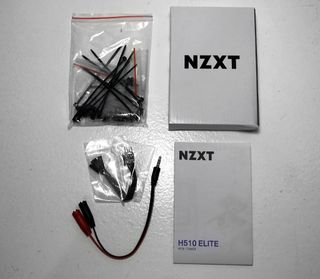
Test Configuration
Drivers & Settings
| Chipset | Intel INF 10.1.1.42 |
| CPU | 4GHz (40x 100MHz) @ 1.1V core |
| Motherboard | Firmware 1.10 3/2/2018 |
| RAM | 14-14-14-34 |
| Graphics | Maximum Fan for Thermal Tests | NVIDIA GeForce 398.36 WHQL Game Ready Driver |
Interior



The interior of this chassis is virtually identical to the H510, H500i and others, which is a good thing. The hard drive racks are hidden, there are no optical drive bays, and the intake fans are tucked out of the way and the company's trademarked cable management bar that spans from the top of the main compartment to the top of the PSU compartment. Altogether, this makes for an extremely clean look. Despite this being a "compact" mid-tower, there is plenty of room for a variety of system builds.

The inside of the H500i is painted to match the exterior of the case (black in the case of our review unit) as is the cable management bar (also available in white). There are no traditional cable pass-through holes in the motherboard tray. Instead, the company has opted for a 216 x 45mm vertical slot for cable management.
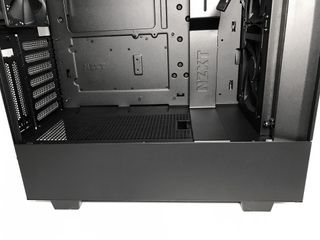
Getting into the guts of the H510 Elite, coolers as tall as 165mm can be installed in this chassis. Although multi-GPU setups aren't as prevalent as they used to be, those of you that do run more than one graphics card will be delighted to know that this chassis' seven expansion slots can accommodate graphics cards up to 381mm (15 inches) in length without radiators or all-in-one coolers installed in the front of the chassis. There is a 190 x 25mm opening in the upper edge of the motherboard tray that's designed to allow routing the fan wires and your 12V motherboard power cable. A large hole in the motherboard mounting plate facilitates heatsink changes without removing the motherboard.
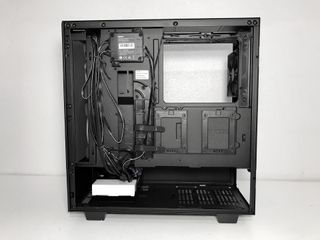
The area behind the motherboard tray features plenty of tie down points and several removable plastic routing blocks designed to aid in cable management.
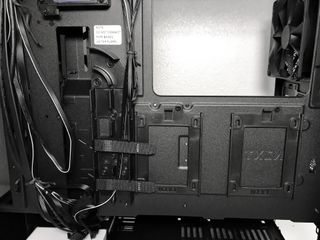
Also located behind the motherboard tray is NZXT's new Smart Device 2. Its faster microprocessor controls two HUE 2 RGB lighting and three fan channels, and supports both voltage regulated and PWM fans.
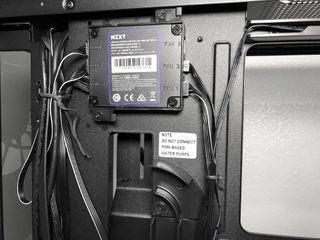
The Smart Device 2 is controlled by the company's proprietary CAM software.



There are mounts for two 3.5-inch hard drives and two 2.5-inch drives. The default hard drive mounts are located behind the motherboard tray or under the PSU tunnel. Alternatively, the two 2.5" plastic drive caddies can be mounted to the top of the PSU tunnel. As with the H500i, the two mounting locations inside the PSU compartment do not feature drive caddies and hard drives are held in place by screws. This means that swapping a drive requires putting the system on its left side and unscrewing the drive cage from the H510 Elite’s bottom panel.
Cooling


There are mounting locations for up to four 120mm fans; two in the front, one in the top panel, and a single rear. Alternatively, the H510 Elite can be equipped with three 140mm fans; two in the front and one in the top. The case ships by default with two 140mm RGB intake and a standard 120mm exhaust fan.



Radiators and all-in-one liquid coolers up to 280mm can be mounted inside the front of the main compartment of the chassis but, because of the protruding cable management bar, we were unable to mount fans in a push-pull configuration. The exhaust fan mount can be fitted with 120mm coolers in single or sandwiched configurations.


The removable fan / radiator bracket in the front of the chassis makes the process of installing radiators and all-in-one coolers in this area painless. Keep in mind that the thickness of your radiator/all-in-one cooler and fans will subtract from the overall length of GPU you will be able to use.



We tested power supplies up to 220mm in length without any issues or the need to move the hard drive racks.
MORE: Best Cases
MORE: All Case Content
Current page: Hardware Installation and Test Configuration
Prev Page Features and Specifications Next Page Benchmark Results and ConclusionStay on the Cutting Edge
Join the experts who read Tom's Hardware for the inside track on enthusiast PC tech news — and have for over 25 years. We'll send breaking news and in-depth reviews of CPUs, GPUs, AI, maker hardware and more straight to your inbox.
-
stinhambo Correction: The 510 Elite only comes with two RGB fans, the exhaust is a non-RGB AER F120.Reply